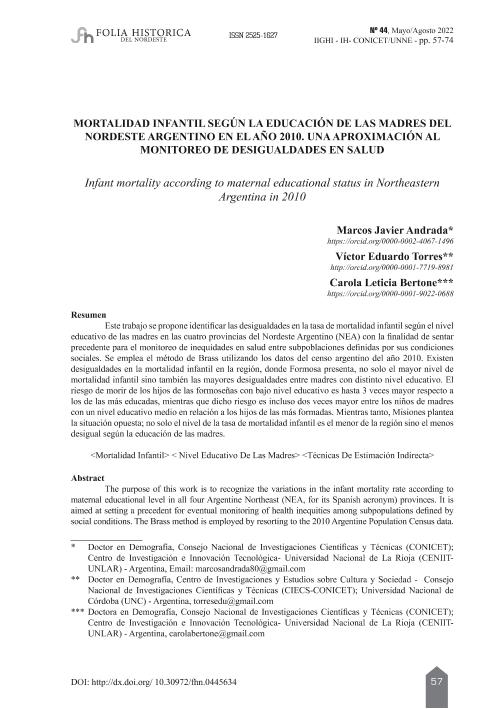Mostrar el registro sencillo del ítem
dc.contributor.author
Andrada, Marcos Javier

dc.contributor.author
Torres, Victor Eduardo Roque

dc.contributor.author
Bertone, Carola Leticia

dc.date.available
2023-10-04T11:33:28Z
dc.date.issued
2022-06
dc.identifier.citation
Andrada, Marcos Javier; Torres, Victor Eduardo Roque; Bertone, Carola Leticia; Mortalidad infantil según la educación de las madres del Nordeste Argentino en el año 2010: Una aproximación al monitoreo de desigualdades en salud; Consejo Nacional de Investigaciones Científicas y Técnicas. Instituto de Investigaciones Geohistóricas; Folia Histórica del Nordeste; 44; 6-2022; 54-74
dc.identifier.issn
0325-8238
dc.identifier.uri
http://hdl.handle.net/11336/214026
dc.description.abstract
Este trabajo se propone identificar las desigualdades en la tasa de mortalidad infantil según el nivel educativo de las madres en las cuatro provincias del Nordeste Argentino (NEA) con la finalidad de sentar precedente para el monitoreo de inequidades en salud entre subpoblaciones definidas por sus condiciones sociales. Se emplea el método de Brass utilizando los datos del censo argentino del año 2010. Existen desigualdades en la mortalidad infantil en la región, donde Formosa presenta, no solo el mayor nivel de mortalidad infantil sino también las mayores desigualdades entre madres con distinto nivel educativo. El riesgo de morir de los hijos de las formoseñas con bajo nivel educativo es hasta 3 veces mayor respecto a los de las más educadas, mientras que dicho riesgo es incluso dos veces mayor entre los niños de madres con un nivel educativo medio en relación a los hijos de las más formadas. Mientras tanto, Misiones plantea la situación opuesta; no solo el nivel de la tasa de mortalidad infantil es el menor de la región sino el menos desigual según la educación de las madres.
dc.description.abstract
The purpose of this work is to recognize the variations in the infant mortality rate according to maternal educational level in all four Argentine Northeast (NEA, for its Spanish acronym) provinces. It is aimed at setting a precedent for eventual monitoring of health inequities among subpopulations defined by social conditions. The Brass method is employed by resorting to the 2010 Argentine Population Census data. There are variations in the infant mortality rate in the aforementioned region. On the one hand, the highest infant mortality rate is seen in Formosa, where there are also the largest inequalities among mothers according to their educational level. Children whose mothers have the lowest educational level are up to three times more likely to die than those whose mothers have the highest educational level. Children whose mothers have medium educational level are twice more likely to die than those whose mothers have the highest educational level. On the other hand, the situation in Misiones is quite the opposite. There is the lowest infant mortality rate and there are not many inequalities among mothers according to their education level.
dc.format
application/pdf
dc.language.iso
spa
dc.publisher
Consejo Nacional de Investigaciones Científicas y Técnicas. Instituto de Investigaciones Geohistóricas
dc.rights
info:eu-repo/semantics/openAccess
dc.rights.uri
https://creativecommons.org/licenses/by-nc/2.5/ar/
dc.rights.uri
https://creativecommons.org/licenses/by-nc/2.5/ar/
dc.subject
MORTALIDAD INFANTIL
dc.subject
NIVEL EDUCATIVO DE LAS MADRES
dc.subject
TECNICAS DE ESTIMACION INDIRECTA
dc.subject.classification
Demografía

dc.subject.classification
Sociología

dc.subject.classification
CIENCIAS SOCIALES

dc.title
Mortalidad infantil según la educación de las madres del Nordeste Argentino en el año 2010: Una aproximación al monitoreo de desigualdades en salud
dc.title
Infant mortality according to maternal educational status in Northeastern Argentina in 2010
dc.type
info:eu-repo/semantics/article
dc.type
info:ar-repo/semantics/artículo
dc.type
info:eu-repo/semantics/publishedVersion
dc.date.updated
2023-07-19T15:38:11Z
dc.identifier.eissn
2525-1627
dc.journal.number
44
dc.journal.pagination
54-74
dc.journal.pais
Argentina

dc.journal.ciudad
Resistencia
dc.description.fil
Fil: Andrada, Marcos Javier. Universidad Nacional de La Rioja. Secretaría de Ciencia y Tecnología. Centro de Investigación e Innovación Tecnológica; Argentina. Consejo Nacional de Investigaciones Científicas y Técnicas; Argentina
dc.description.fil
Fil: Torres, Victor Eduardo Roque. Consejo Nacional de Investigaciones Científicas y Técnicas. Centro Científico Tecnológico Conicet - Córdoba. Centro de Investigaciones y Estudios sobre Cultura y Sociedad. Universidad Nacional de Córdoba. Centro de Investigaciones y Estudios sobre Cultura y Sociedad; Argentina. Universidad Nacional de Córdoba. Facultad de Ciencias Económicas; Argentina
dc.description.fil
Fil: Bertone, Carola Leticia. Consejo Nacional de Investigaciones Científicas y Técnicas; Argentina. Universidad Nacional de La Rioja. Secretaría de Ciencia y Tecnología. Centro de Investigación e Innovación Tecnológica; Argentina
dc.journal.title
Folia Histórica del Nordeste
dc.relation.alternativeid
info:eu-repo/semantics/altIdentifier/url/https://revistas.unne.edu.ar/index.php/fhn/article/view/5634
dc.relation.alternativeid
info:eu-repo/semantics/altIdentifier/url/http://www.scielo.org.ar/scielo.php?script=sci_arttext&pid=S0325-82382022000200057
dc.relation.alternativeid
info:eu-repo/semantics/altIdentifier/url/https://dialnet.unirioja.es/servlet/articulo?codigo=8822347
Archivos asociados
